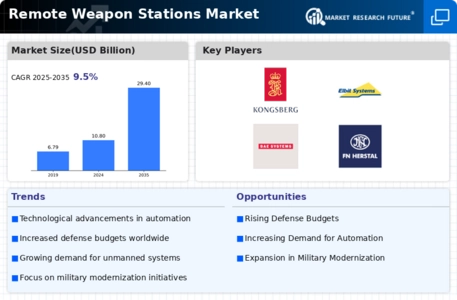Top Industry Leaders in the Remote Weapon Stations Market

Remote Weapon Stations (RWS) Market
The global Remote Weapon Stations (RWS) market has witnessed significant growth in recent years, driven by increasing defense budgets, modernization initiatives, and the need for enhanced situational awareness on the battlefield. As the demand for advanced military capabilities rises, the competitive landscape of the RWS market becomes increasingly dynamic, with key players striving to gain a competitive edge through strategic initiatives, technological advancements, and collaborations.
Key Players:
Kongsberg Gruppen (Norway)
Raytheon Company (US)
Elbit Systems (Israel)
Saab AB (Sweden)
Leonardo S.p.A. (Italy)
BAE Systems (UK)
Rheinmetall AG (Germany)
ASELSAN A.S (Turkey)
FN Herstal (Belgium)
Strategies Adopted:
To maintain their competitive positions, key players in the RWS market have adopted various strategies. One common approach is technological innovation, with a focus on developing advanced features such as fire control systems, integration capabilities, and improved precision. Collaboration and partnerships have also become prevalent, allowing companies to leverage each other's strengths and expand their market reach. Additionally, a strategic emphasis on customization and flexibility in RWS design enables companies to address specific customer needs and preferences.
Factors for Market Share Analysis:
Market share analysis in the RWS sector is influenced by several factors. Technological innovation and the ability to provide cutting-edge solutions play a crucial role in gaining market share. Companies investing in research and development to enhance their RWS capabilities are likely to secure a competitive advantage. Furthermore, the ability to forge partnerships and collaborations with defense organizations, as well as maintaining a strong global presence through effective marketing and distribution channels, are key factors determining market share.
New and Emerging Companies:
While established players dominate the RWS market, new and emerging companies are making significant strides. These entrants often focus on niche markets, offering specialized solutions and innovative features. Examples include Aselsan A.Ş., a Turkish defense company gaining recognition for its RWS offerings, and FN Herstal, a Belgian company with a growing presence in the sector. These newcomers bring fresh perspectives and competition, prompting established players to continually refine their strategies and products.
Industry News:
Recent developments in the RWS market indicate its evolving nature. One notable trend is the integration of artificial intelligence (AI) and autonomous capabilities into RWS technology, enhancing real-time decision-making and target identification. Additionally, advancements in materials and manufacturing processes contribute to lighter, more durable RWS designs. Ongoing geopolitical developments also impact the market, influencing defense budgets and procurement strategies, thereby shaping the competitive landscape.
Current Company Investment Trends:
Key players in the RWS market are actively investing in research and development to stay ahead of the curve. This involves exploring emerging technologies, such as AI, machine learning, and sensor integration, to enhance the capabilities of their RWS offerings. Moreover, companies are investing in expanding their production capabilities to meet the growing demand for RWS globally. Strategic acquisitions and partnerships are also evident, allowing companies to strengthen their product portfolios and gain access to new markets.
Overall Competitive Scenario:
The overall competitive scenario in the Remote Weapon Stations market is characterized by intense rivalry among major players, as they strive to innovate and meet evolving defense requirements. The focus on technological advancement, strategic partnerships, and customization capabilities remains paramount. Companies that successfully navigate these dynamics position themselves for sustained growth in a market driven by the ever-changing landscape of global security challenges.
As the Remote Weapon Stations market continues to evolve, competition among key players intensifies. The strategies adopted, technological innovations, and investment trends shape the competitive landscape. While established companies maintain their dominance, new entrants bring diversity and fresh perspectives. The industry's response to emerging technologies and geopolitical developments will determine future market dynamics, making it imperative for players to stay agile and adaptive to secure their positions in this dynamic and vital sector.
Recent News :
Secured a contract with the US Army for the delivery of Protector RWS equipped with M230LF 30mm cannons and Javelin missiles. (Nov 2023)
Unveiled a new lightweight RWS specifically designed for Special Forces applications. (Oct 2023)
Awarded a contract by an Asian-Pacific country to supply unmanned turrets for Armored Fighting Vehicles, worth USD 80 million. (Sep 2022)
Successfully integrated its IronVision helmet-mounted display system with its UT30 RWS, enhancing situational awareness for operators. (Aug 2023)
Showcased its HITFACT II RWS with integrated electro-optical and laser rangefinder systems at a recent defense exhibition. (Dec 2023)
Partnered with a local company in India to explore opportunities for joint development and production of IR RWS for the Indian defense forces. (Nov 2023)
Launched its RAPIDFire RWS featuring a modular design and advanced sensor suite for improved target acquisition and engagement. (Oct 2023)
Secured a contract with the French Army for the upgrade of its RWS fleet with next-generation infrared sensors and fire control systems. (Sep 2023)
Developed a new compact and lightweight RWS specifically designed for light armored vehicles and patrol boats. (Jan 2024)
Partnered with a US company to explore the integration of its Trophy active protection system with RWS platforms for enhanced survivability. (Dec 2023)


